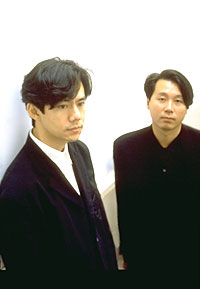|
|
|
||||||
|
|
|||||||
|
Both educated at Kyoto City University of Art, TOWATA Masayuki and MATSUMOTO Yasuaki began their collaboration with their 1991 project <<Divina Commedia>>.
Held at Kobe's Xebec Hall from August 28 to September 2, 1991, <<Divina Commedia: Death's Praxis>>, an installation simulating death, was true to its title in its large scale and use of a somewhat secretive process. Five test subjects were made to wear dustproof suits and lie horizontally while floating in a giant pool of blue gel. Showered with the stimuli of flashing lights and sound effects, the five gradually began to feel the extraordinary tranquility of having satisfied the desire to return to their mothers' wombs; and having lost all bodily sensation, they said, they lapsed into a state where only their brains remained active. The installation took as its theme The Divine Comedy, in which DANTE sublimates the absolutism of romantic love into lyrical poetry about "death and rebirth." This installation used the transformation of bodily sensations via technology as a means to experience really "death and rebirth." |
 |
|
|
While <<Divina Commedia>> can in some ways be called a group experience for the five who participated, <<Trobar Clus>> (1992-93), an installation exhibited at Art Tower Mito Contemporary Art Center, was designed for a truly solitary experience. The name <<Trobar Clus>> appears in a work by Hieronymus Bosch, in which he describes a transparent sphere; it refers to a perforating object. Gel was poured into a transparent tank large enough for one person to lie horizontally; the tank weighed as much as 700 kg and was elevated two meters in the air by thin iron beams. When the test subject, chosen from a group of volunteers, was positioned horizontally, the flashing of data began. Through a definitive interchange between the spectators and participants--the viewer and the viewed--the installation aimed for a bodily experience of "death and rebirth" within an open environment.
|
Another joint production by TOWATA and MATSUMOTO was their installation entitled <<Gravity and Grace>> created for "MultiMediale 4" (May 1995, ZKM, Karlsruhe, Germany). Standing in front of the installation, visitors can see the faint appearance of a "spirit" overlapping with their own image in a dim mirror. The title of the piece, dedicated to the victims of the Hanshin (Kobe) Earthquake, was taken from Simone WEIL's book of the same name. According to WEIL, the natural movements of the spirit are controlled by "a law similar to the law of material gravity," the only exception from which is "grace." This installation encouraged an awareness of the human body's vulnerable existence and of the transcendental quality that controls the psyche.
While each of these projects relied on the references suggested in their titles to summon a theoretical background, they each began with the medium of the participants' bodies. Accordingly, the notion of "gravity," which exists as one vector, is clarified in a variety of ways and the participants are instilled with the premonition of another supernatural force that may suddenly be born therein. These are what WEIL calls "the two controlling forces of the universe," and it is surely these two things that the works of TOWATA and MATSUMOTO lead us to experience.I (SHIRAI Masato)
|
|